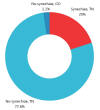Risk factors leading to the formation of intranasal synechiae (adhesions) in patients who underwent septo- and septoturbinoplasty (a retrospective cohort Study)
- PMID: 40486557
- PMCID: PMC12140727
- DOI: 10.1097/MS9.0000000000003223
Risk factors leading to the formation of intranasal synechiae (adhesions) in patients who underwent septo- and septoturbinoplasty (a retrospective cohort Study)
Abstract
Introduction: Intranasal adhesions (synechiae) are common complications of nasal surgery. This study aimed to analyze the factors influencing the development of synechiae, with particular emphasis on the use of nasal septal splints. We also propose a solution to reduce the incidence of this complication in the future.
Methodology: This retrospective analysis of patients (n = 243) who underwent septoplasty and septoconchoplasty between 2017 and 2022.
Results: Iatrogenic intranasal synechiae occurred in 26.75% (65/243) of patients. Among patients who received nasal septal splints, synechiae occurred in 13.1%. Synechiae complicated 46.9% of the surgeries in the group without separators (P < 0.001). There was no statistically significant relationship between increased risk of synechiae and concomitant conchoplasty (26% vs. 27.7%, P = 0.817). Patients with seton gauze dressings experienced synechiae significantly more often than those with nasal tampons or other gauze dressings (P < 0.001).
Conclusions: The use of nasal septal separators and tampons significantly reduces the risk of iatrogenic intranasal synechiae following septoplasty or septoconchoplasty, regardless of the degree of nasal septum deviation. Conversely, the use of seton gauze dressings is associated with a higher risk of developing synechiae.
Keywords: nasal septum; nasal surgical procedures; turbinates.
Copyright © 2025 The Author(s). Published by Wolters Kluwer Health, Inc.
Conflict of interest statement
Sponsorships or competing interests that may be relevant to content are disclosed at the end of this article. Nothing to declare.
Figures







Similar articles
-
Intranasal Synechiae as Complications of Rhinosurgical Treatment-A Review of Current Knowledge.J Clin Med. 2023 Oct 29;12(21):6831. doi: 10.3390/jcm12216831. J Clin Med. 2023. PMID: 37959296 Free PMC article. Review.
-
Use of nasal packs and intranasal septal splints following septoplasty.Int J Oral Maxillofac Surg. 2009 Oct;38(10):1022-4. doi: 10.1016/j.ijom.2009.05.012. Epub 2009 Jul 4. Int J Oral Maxillofac Surg. 2009. PMID: 19577902 Clinical Trial.
-
[Comparative analysis of different types of tampons used after septoplasty, conchotomy of the inferior turbinates].Vestn Otorinolaringol. 2024;89(5):16-22. doi: 10.17116/otorino20248905116. Vestn Otorinolaringol. 2024. PMID: 39545756 Russian.
-
Comparative study of intranasal septal splints and nasal packs in patients undergoing nasal septal surgery.Ear Nose Throat J. 2014 Sep;93(9):396-408. Ear Nose Throat J. 2014. PMID: 25255346 Clinical Trial.
-
Quilting Suturing Versus Intranasal Silicone Splinting and Nasal Pack Post-Septoplasty: A Systematic Review and Meta-analysis.Aesthetic Plast Surg. 2025 Feb 28. doi: 10.1007/s00266-024-04642-6. Online ahead of print. Aesthetic Plast Surg. 2025. PMID: 40021506 Review.
References
-
- Niemczyk K, Jurkiewicz D, Składzień D, et al. . Otolaryngologia Kliniczna. Vol 2 ed. Warsaw: Medipage; 2015: 314–16.
-
- Bochenek A, Reicher M. Anatomy of Man Vol 2, 9th edition (reprint). Warsaw: PZWL; 2008: 325–42.
-
- Theissing J, Rettinger G, Werner JA. Otorhinolaryngology. Head and Neck Surgery. Niemczyk K, ed. Warsaw:Medmedia; 2014:49–79.
-
- Watters C, Brar S, Yapa S. Septoplasty 2022 Nov 8. In: StatPearls [Internet]. Treasure Island (FL): StatPearls Publishing; 2024. Jan. PMID: 33620795. - PubMed
-
- Egbert H. Incorrect terminology in nasal anatomy and surgery, suggestions for improvement. Rhinology 2003;41:129–33. - PubMed
LinkOut - more resources
Full Text Sources
